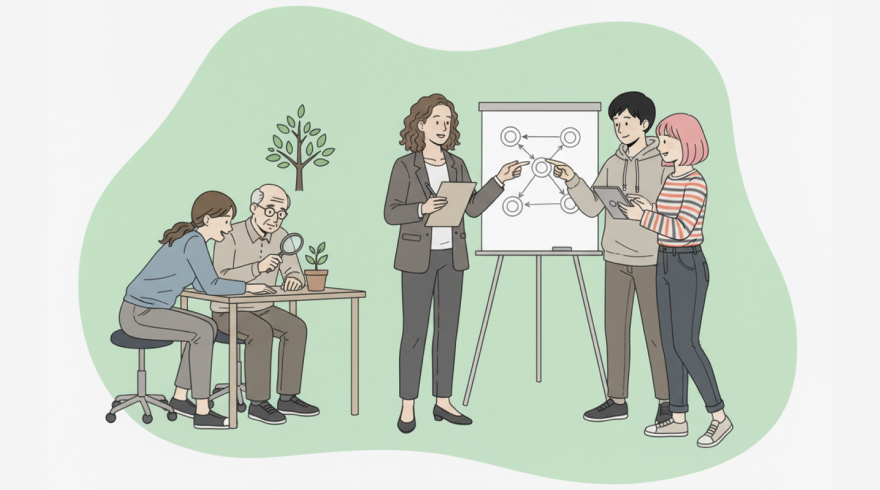Leadership Skills Style for Modern Teams: Capabilities, Benefits, and Assessment
- 19 October 2025

The Essence of Modern Leadership
Great leadership is less about authority and more about creating conditions where people do their best thinking. Today’s environment rewards clarity, curiosity, and courageous decision-making, especially when information is incomplete. Leaders who align purpose with pragmatic execution unlock momentum across functions. They set direction, remove friction, and amplify the voices closest to the problem.
Real progress emerges when managers orchestrate communication, commitments, and cadence with intention. In practice, the craft of leadership skills remains central to coordinating people, processes, and technology. Effective leaders shape context, not just content, and they translate ambiguity into choices, experiments, and measurable learning.
Vision becomes credible when it is paired with disciplined operating rhythms and thoughtful feedback loops. Beyond title or tenure, practitioners weave together different leadership skills to navigate uncertainty with grace. The resulting trust compacts allow teams to move fast, challenge assumptions, and keep promises without burning out.
- Build psychological safety so ideas and risks are surfaced early.
- Translate strategy into weekly behaviors and observable outcomes.
- Hold crisp agreements on priorities, owners, and timelines.
- Teach teams how to learn from small bets, not just big launches.
Core Qualities and Behaviors That Elevate Performance
Outstanding leaders blend credibility with compassion and make expectations unmistakably clear. They listen for meaning, not just words, and they deliver feedback that is specific, timely, and fair. Decisions balance speed with diligence, honoring both data and context. Crucially, they model the standards they ask of others, especially under pressure.
Choosing what to strengthen first requires a candid look at the work, the culture, and the immediate constraints. When choosing focus areas, map your strengths against leadership skills and qualities that your context rewards most. That alignment prevents generic development plans and instead channels energy toward capabilities that compound.
Consistency turns ambition into outcomes, and habits harden character. Patterns like modeling the way and coaching peers underpin successful leadership skills across diverse industries. Leaders who track promises, celebrate useful failure, and confront issues early create an environment where excellence is both expected and teachable.
- Clarity: say the why, the what, and the measure of done.
- Composure: regulate emotions so teams can regulate attention.
- Candor: name reality kindly and move toward resolution.
- Curiosity: ask better questions before prescribing answers.
Tangible Benefits for Teams and Organizations
High-caliber leadership reduces waste, accelerates cycle times, and increases customer loyalty. It turns meetings into decisions and roadmaps into shipped value. The benefits are not only financial; engagement rises, attrition drops, and cross-functional friction gives way to collaborative problem-solving. Well-led teams also demonstrate better resilience when priorities shift.
Modern organizations treat feedback as a strategic asset rather than a compliance exercise. For sentiment and culture signals, circulate a concise leadership skills questionnaire that ties insights to action items. When feedback pathways are visible and safe, people contribute their best thinking because they see it change how work gets done.
Sustained gains require continuous learning, not one-off workshops or motivational slogans. To sustain focus over time, log observations into a living leadership skills inventory that your team can revisit. This artifact helps leaders spot pattern gaps, align development sprints, and avoid repeating the same mistakes across projects.
- Stronger execution: fewer handoffs, clearer ownership, faster resolution.
- Better decisions: blended evidence from customers, data, and frontline insight.
- Healthier culture: norms that reward accountability and mutual respect.
- Strategic agility: capacity to shift without losing cohesion or quality.
Assessment and Development Pathways
Measurement turns aspiration into an operating system for growth. Many organizations prioritize assessment leadership skills programs during strategic resets to anchor growth. By mixing qualitative narratives with quantitative benchmarks, leaders gain a multi-angle view of strengths, blind spots, and leverage points.
Method selection should fit maturity, budget, and the decisions you need to make. A blended approach pairs 360 reviews with a calibrated leadership skills assessment to balance depth and scale. The goal is to collect reliable signals that directly inform coaching plans, role design, and succession choices.
| Method | Best For | Typical Length | Signal Strength | Notes |
|---|---|---|---|---|
| 360-Degree Review | Context-rich feedback from peers and reports | 2–3 weeks | High | Requires trust and anonymity to surface candor |
| Behavioral Interview | Role-specific capability mapping | 60–90 minutes | Medium–High | Skilled interviewers improve reliability markedly |
| Scenario Simulation | Decision-making under pressure | Half-day | High | Great for leadership team calibration |
| Validated Psychometric | Traits and preferences at scale | 20–40 minutes | Medium | Pair with qualitative data for full picture |
| Pulse Survey | Fast, broad sentiment checks | 5–10 minutes | Medium | Useful for trend tracking between deep dives |
Standardization helps compare apples to apples across cohorts and time. For speed and comparability, consider a validated leadership skills test alongside qualitative feedback. That combination supplies both the texture of real contexts and the consistency required for fair decisions.
Language clarity and item quality determine how useful the results become. Where depth of reflection is needed, deploy a structured leadership skills assessment questionnaire to surface patterns. Follow-up conversations then translate insights into specific habits, coaching drills, and milestones.
Practical Playbook for Daily Leadership
Execution thrives on rhythm, not heroics. Set a weekly cadence for planning, focused work, and retrospective learning so improvement becomes inevitable. Set monthly challenges that deliberately involve testing leadership skills under realistic constraints. By treating development like a sport, leaders train fundamentals, review footage, and iterate fast.
- Hold 15-minute standups that end with clear owners and commitments.
- Use decision logs to record assumptions, options, and chosen bets.
- Run pre-mortems to surface risks and countermeasures before kickoff.
- Start and end meetings on time, documenting next steps in plain language.
Measurement should feel supportive, not punitive, and it should scale with complexity. Quarterly sprints can include a targeted leadership skills assessment test to track momentum. Tie results to one behavioral experiment per person, and celebrate observable changes rather than abstract intentions.
Leaders who journal, coach in the moment, and ask for real-time feedback build a compound advantage. Over time, these practices create a culture where initiative is rewarded, clarity is contagious, and reliability is the default. The compounding effect of small improvements, kept consistently, reshapes performance curves across the organization.
Faq: Leadership Essentials
What distinguishes a great leader from a good manager?
A great leader articulates purpose, sets a direction, and cultivates conditions where people do their most creative work, while a good manager ensures plans are executed reliably. You need both, and the same person can wear both hats, but the emphasis and mindset differ in scope and time horizon.
How can I lead effectively without formal authority?
Influence through credibility: earn trust by keeping promises, share useful context, and solve real problems for peers. Offer help, ask sharp questions, and bring data that clarifies choices. Over time, consistent value creation earns you the permission to guide decisions.
What is the fastest way to improve as a leader?
Pick one behavior that matters in your context, practice it daily, and solicit targeted feedback. Small, observable changes compound quickly when tied to real work. Pair this with short retrospectives to capture lessons and adjust your next experiment.
How do I give feedback that actually helps?
Make it timely, specific, and actionable. Describe observable behavior, its impact, and a clear next step. Ask how you can support the change, and agree on a follow-up to review progress. Keep the tone candid and respectful, focused on growth rather than blame.
How should leadership development be measured?
Use multiple signals: behavior observation, peer input, outcome metrics, and structured tools that track change over time. Blend quantitative trends with qualitative stories so you understand not only whether progress occurred, but also why and how to sustain it.
Latest News
-
![The Complete Guide to Modern Leadership Style Assessment]()
- 21 October, 2025
-
![The Ultimate Guide to Identifying and Applying Your Leadership Approach]()
- 20 October, 2025
-
![Management Style: A Practical Guide to Choosing the Right Approach]()
- 18 October, 2025



